Almost 43% of retail e-commerce sales in the US occur during the two-month-long Holiday Season. And so promoting products at this time should clearly be a vital part of your marketing strategy.
But figuring out how to find the most popular products to promote can be a difficult thing to do. How can we possibly know what is going to be popular in the future?
This article lifts the lid on the sorcery behind this annual problem…
What Exactly Is The Holiday Season, (And How Much Is It Worth)?
While the answer may be obvious to most Americans, outside of the US the term can be a little confusing. So, for clarity, the Holiday Season is a North American term for the period of celebrations that take place from Thanksgiving thru New Year’s.
- Thanksgiving – the 4th Thursday of November
- Black Friday – the day after Thanksgiving
- Cyber Monday – the Monday after Black Friday
- Christmas – 25th December
- New Year’s – 31st December/1st January
In 2020, the total figure for retail e-commerce sales in the US was more than $431bn.
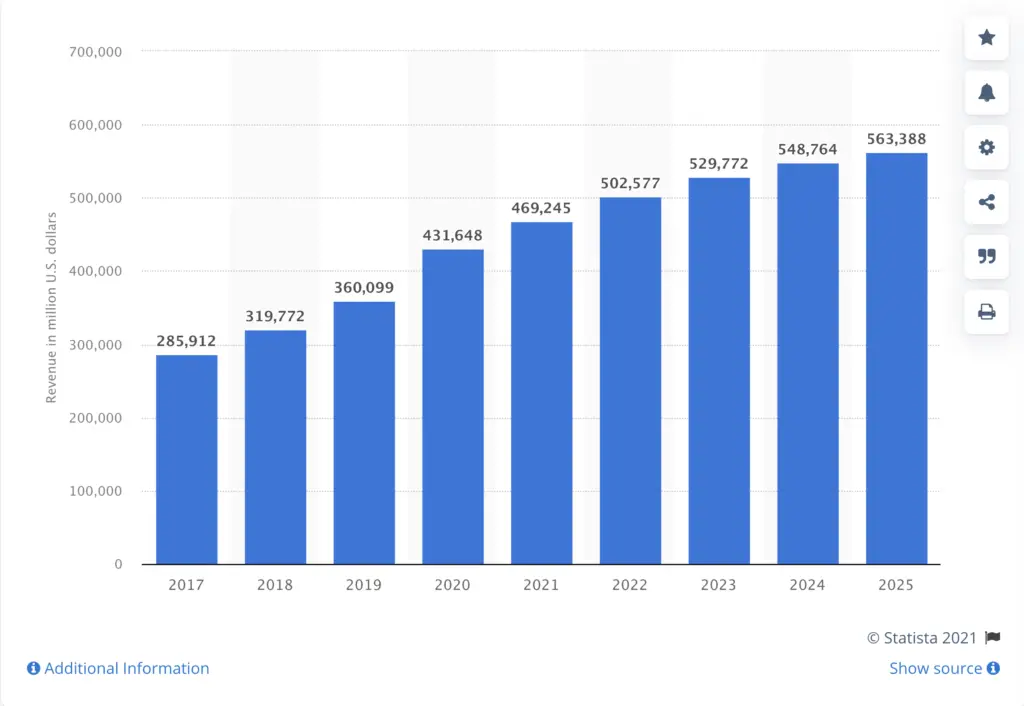
If we split that number down into sales made over the Holiday Season, then we can see the number is just over $185bn.
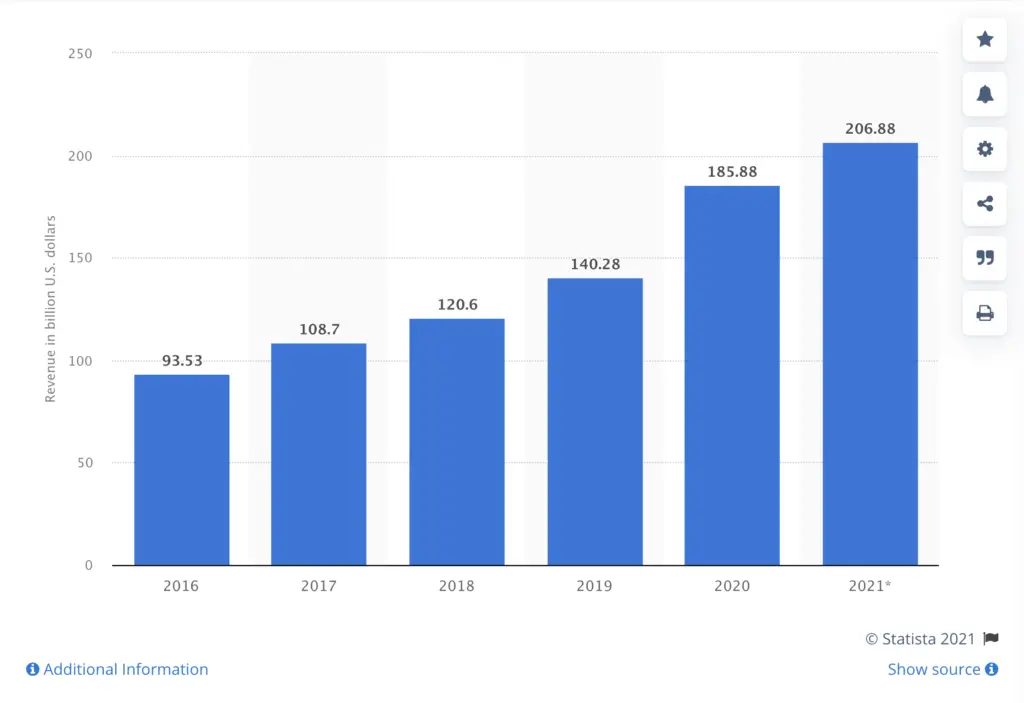
And if we dig a little deeper into that number we can see that the period Thanksgiving through Black Friday/Cyber Monday (also known as Cyber Five), accounted for $34.3bn during that five-day period alone (Statista).
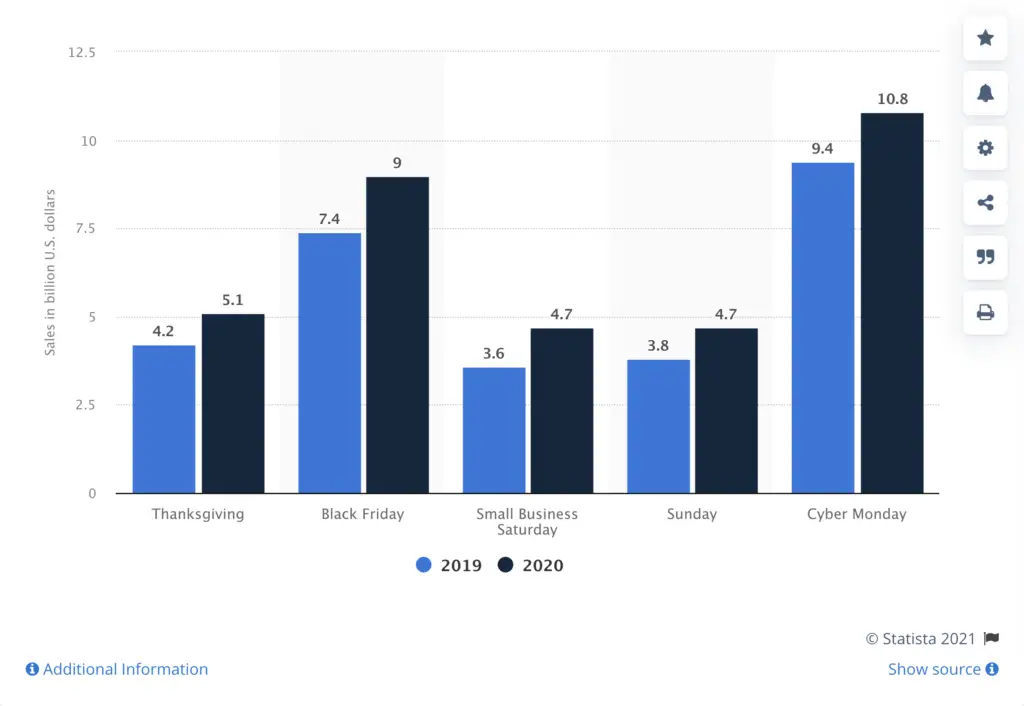
As an affiliate marketer, ensuring that you carve out as much referral income as possible for this frenzied shopping period should be a priority. And knowing the most popular products to promote is clearly going to be crucial to your success…
How Do You Find A Trending Product?
There are a number of ways we can research which products are trending. It’s useful to remember at this point that in order to get the most accurate prediction, you’ll need to use a combination of options.
It’s a little like cooking a curry – you wouldn’t just use one spice, but rather a subtle blend of many to create the perfect dish. Finding a trending product follows a similar recipe…
Google Trends
The first place to look when searching for the most popular products to promote should be Google Trends. It’s a fantastically useful resource that allows us to quickly see search stats tailored to the following metrics:
- Geographical Location
- Time frame – from 2004-present, or as short as the past 1 hour
- Categories
- Type of web search
- Image
- News
- Shopping
- YouTube
Let’s look at an example. Without typing in a specific search term, I selected a worldwide location, a 5-year time frame, Home & Garden as the category, and a general web search. This is the result:
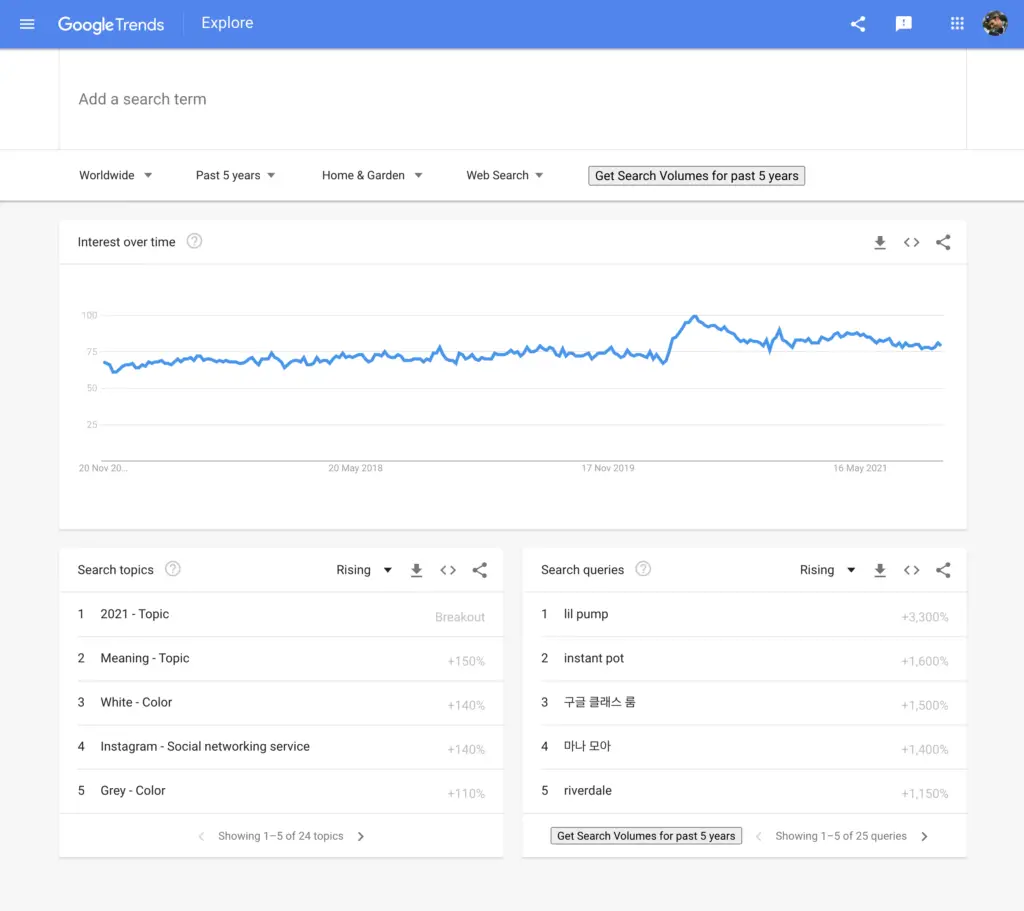
It’s a great example of how Google Trends can show the popularity of a category over time. From November 2016 thru the start of March 2020, the Home & Garden category was pretty steady, with a low of 61 (December 2016) and a high of 79 (June 2019). But when the pandemic hit and we were all house-bound, that number sky-rocketed up to 100 by May 2020.
We can see from the graph that as the world has slowly begun to open up again, Home & Garden as a topic has become less popular, but the search numbers are still higher now than they were pre-pandemic.
Broad category patterns such as these can help us affiliate marketers to predict overall trends. Knowing this can then help us to look closely at those categories and topics to see which products are popular within them.
Topics and Queries
Below the graph are a series of panels showing either Search Topics and Queries or Related Topics and Queries. You can filter by Top or Rising. For trending research, we want to select Rising and this will display a list of the current popular trends related to that topic.
Continuing with our Home & Garden theme, let’s look at a product that would fit into that category – desk lamps. If I type that into the Search Item box and view the worldwide web search stats over a 5 year period, I’m shown this data.
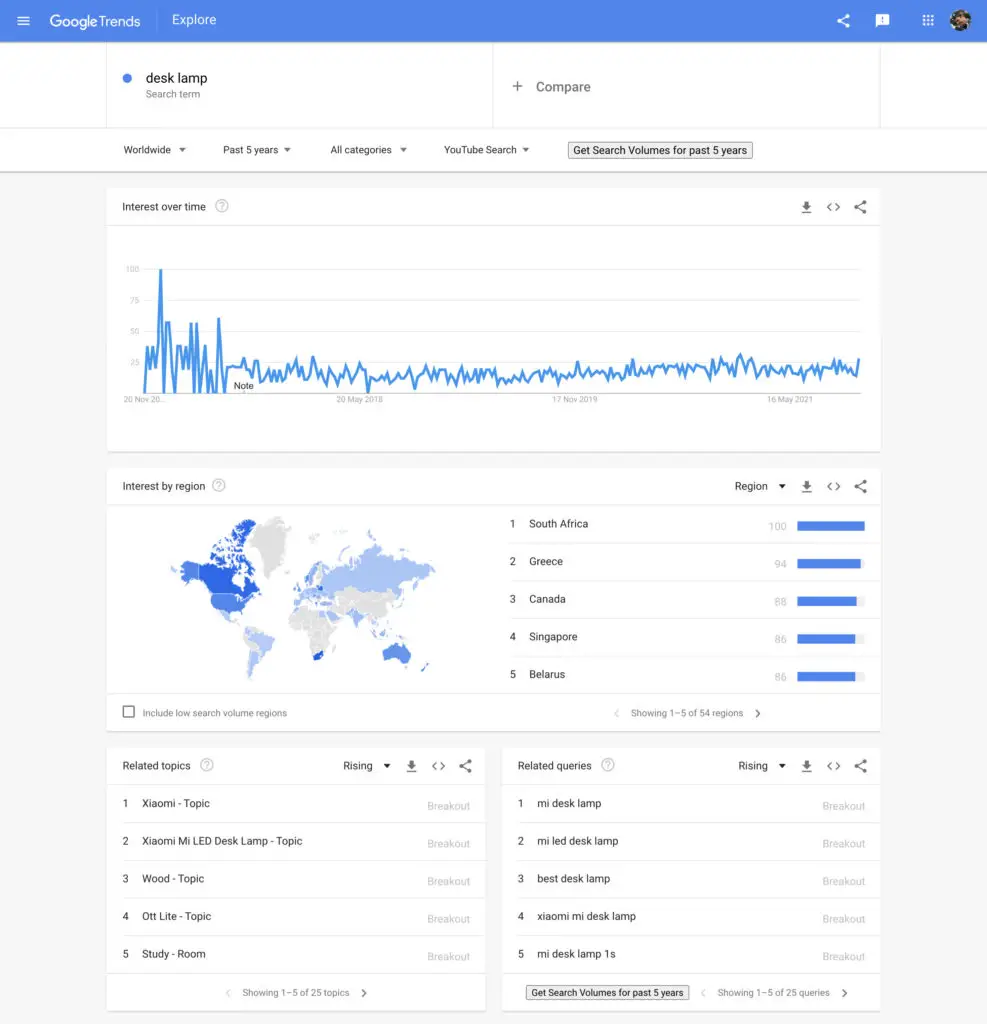
The graph shows me the general movement of the search term but if I look below that I can see the regions that are most popular (there are options to select region or city) as well as related topics and related queries.
Related Topics detail the broad search terms related to ‘desk lamps’ while Related Searches show the specific search terms. Both of these tables tell me that Xiaomi is a popular brand right now, with both topics and queries registering as breakout (this means the increase is 5000% or greater!). I’d then cross-reference these findings using a mix of the tactics below.
Comparing Searches in Google Trends
If lamps were my niche, Google Trends really allows me to see how different types compare to each other. In the example below I’ve compared ‘desk lamps’, ‘floor lamps’ and ‘LED lamps’.

Google Trends gives a stack of useful data and the graph really shows how the search terms compare against one another. All of this is highly useful for helping to determine which topics are rising, and from that, what the most popular products to promote may be.
For a quick 5 minute guide on how to use Google Trends, check out this video.
Bestsellers Lists
Bestsellers lists on established e-commerce sites are a great tool to use to find popular products to promote. But you need to be careful… Just because a product has sold well in the past and is top of the best sellers list, it doesn’t necessarily mean that it’s going to be the most popular this year.
To check, you need to look at the recent sales curve, rather than historical sales over time. Let’s look at a few examples.
Amazon
Amazon allows us to search for products in a number of ways that can help us to determine what the most popular products to promote could be.
Bestsellers
Amazon’s Bestsellers lists can certainly help to inform a decision on which products to promote, but the products listed here should be compared against the Movers and Shakers list, discussed below. If you find a product on both lists – i.e. one that sells well every year and moves up the rankings during Holiday Season – then you know you’re onto a winner.
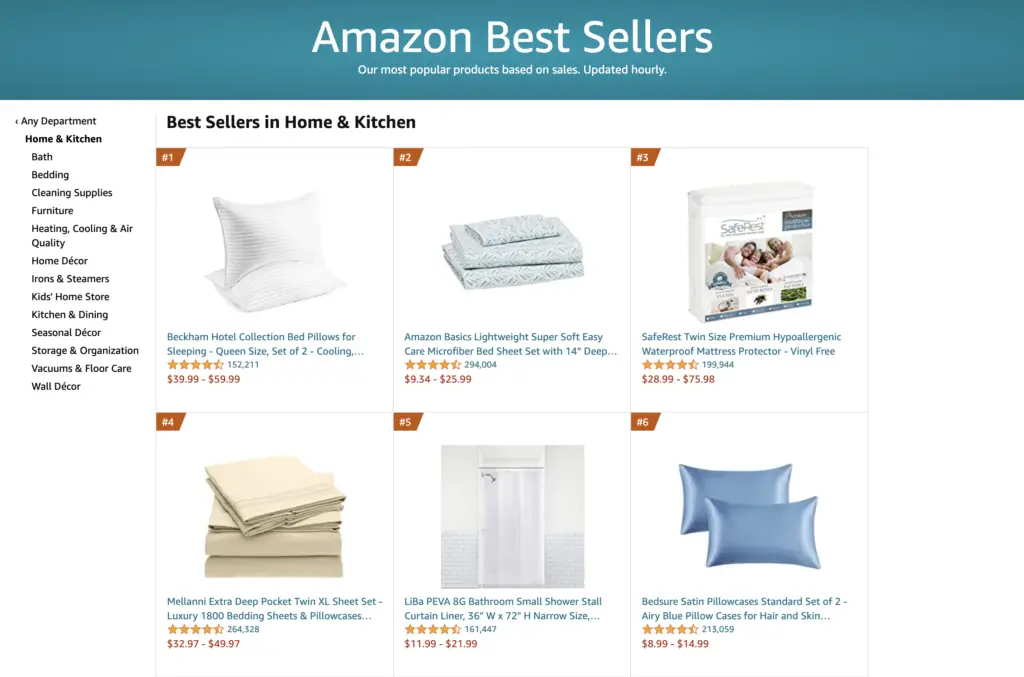
Popular Products From Previous Holiday Season’s
History can help shape the future. Amazon has written a report detailing the best sellers from the 2020 Holiday Season – scroll down to the ‘Best sellers and seasonal trends‘ header for the details. While history is unlikely to repeat itself for the entire list, there are bound to be some repeat products that are annual favourites or new versions of previous best-sellers – like the latest Echo Dot, for example.
Movers and Shakers
Arguably the most useful of Amazon’s ‘future gazing’ metrics are the Movers and Shakers lists. Updated hourly and sortable by category, these lists show the biggest gainers in sales rank over the previous 24 hours. It’s easy to see not only which products are popular, but also by what percentage they’ve increased by.

Most Wished For
We can also search for those items that have been most added to Wishlists and Registries using Amazon’s Most Wished For lists. This can also be a very useful metric – especially when combined with other lists – to see what people are actually wanting.
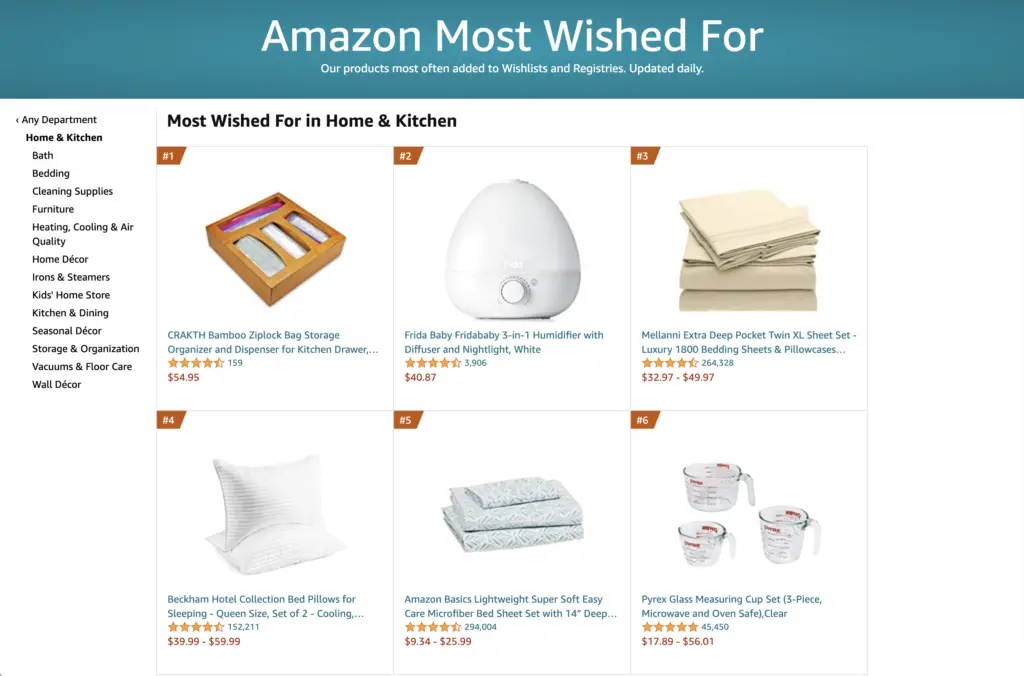
Paid-for Tools
For even more Amazon sales and product information, Jungle Scout offers a set of tools that can help you to deep-dive even further. The Product Tracker tool allows you to track real-time sales and observe key metrics such as units sold, daily sales, and rank.
Similarly, AMZScout offers a PRO Extension that allows users to find and verify profitable products, to see if they trend up or down.
Although the paid-for tools definitely offer up more information, it’s still best to use the data alongside the other methods before finalizing your list of the most popular products to promote.
eBay
eBay has a semi-helpful section called Seasonal Sales & Events. The year’s events are listed in chronological order, so it’s easy to see which items eBay is promoting for each event. However, the categories are broad and the data is limited to two pages worth of product.
There is also a clunky but useful online tool called Watch Count that allows you to see how many people are watching items on the various eBay stores throughout the world. In our ‘Xiaomi Mi led desk lamp’ example, I can see that on eBay.com at least, it’s not being looked at that much.
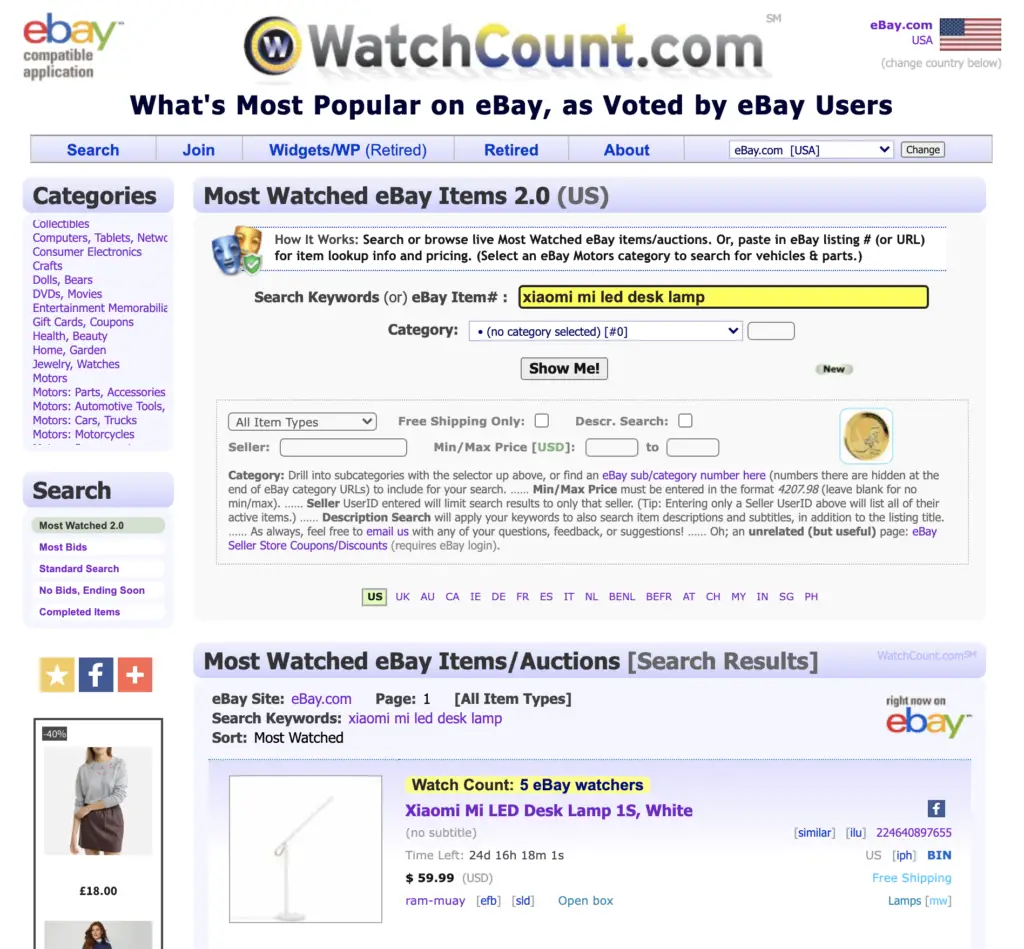
However, as Google Trends also told me that the searches were high in Australia, if I check on ebay.com.au, I can see much more interest:
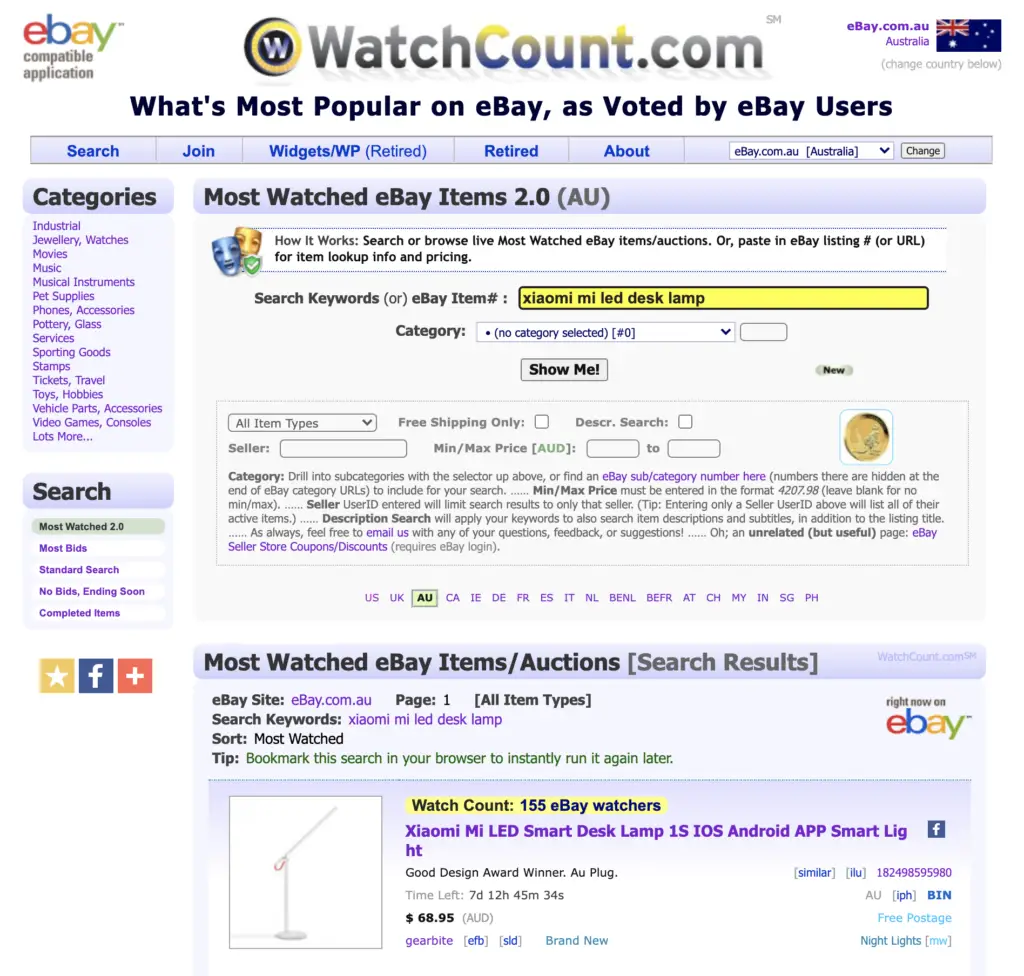
YouTube
As mentioned previously, Google Trends allows you to filter the data to show YouTube search stats. But YouTube itself is a great place to research the most popular products to promote.
You’ll no doubt know who the big YouTube personalities are within your niche. But there will always be some smaller channels that are gathering a loyal following.
The best way to search for what is popular right now on YouTube is to use the filters to modify your search. In the example below, I’ve searched for ‘desk lamps’, and then filtered to show only videos uploaded this month. I’ve then further filtered to sort by view count.


This gives me some interesting results that I know are current and trending. From the results Googe Trends gave me from my earlier ‘desk lamps’ search, I can see that Xiaomi lamps are being searched for a lot, as well as being reviewed by influencers.
Social Media
Big Commerce reports that 43% of global shoppers research products using social media. And, according to the Social Trends 2022 report written by those helpful folk over at Hootsuite, Facebook and Instagram lead the way but Snapchat, TikTok, and Pinterest are growing rapidly.

Whether or not you actively use any or all of the platforms, it’s worth having accounts on each and finding who the influencers are within your niche on each platform. Search relevant keywords to find those influencers – what are they doing? What products are they excited about? Who else are they giving a shout-out to?
Look through the popular section of Pinterest to find products that are trending in your niche. Find products that have generated the largest number of repins.
Join Groups on Facebook, Reddit, and LinkedIn to see what your industry is up to.
Doing this will help you to create a list of the most popular products to promote. Then, plug the answers into the other methods described here and you will have a more accurate picture as to what the current hot trends are.
Trend Publications
There are a number of online publications specifically talking about trends. Excellent places to check include:
Again, use the data alongside other metrics to create a more rounded view of trend patterns so you can generate a list of the most popular products to promote to your audience.
Gift Guides
Sign up to receive seasonal gift guides from leading companies in your niche. The contents of those are often what influence the trends for the Holiday Season, so use the listed products to form your own tailored list for your readers.
Once You Know What To Sell, It’s Time to Maximize Your Sales…
So, now we have some tactics for how to find the most popular products to promote, here is a quick guide on how best to implement your findings.
Start Early
Start creating your killer content well before the Holiday Season in order for it to stand a chance of ranking in Google. Set yourself a deadline for the end of September to have all of your content made ready to deploy.
That said, be ready to pivot should something happen that you know is going to influence the kind of things people buy (like a global pandemic, for example…).
High-Converting Pages And Posts
Finding the most popular products to promote at any given time is only part of the battle. Using the tactics above, you can be extremely thorough in researching which products to recommend to your audience. But if your posts and pages aren’t optimized to encourage your readers to click through, then you really are shooting yourself in the foot.
This is where a tool like AmaLinks Pro® can make an absolute world of difference. Users have reported increased click-through rates of as much as 386%!
By optimizing your sales pages with beautiful product boxes, showcases, comparison tables and fully customizable Call-To-Action buttons, you really are setting yourself up for success.
Try it for yourself – with a no-questions-asked 30-day money-back guarantee, you have absolutely nothing to lose (and potentially a lot to gain).
Email Marketing Campaign
Make a pdf ‘gift guide’ of the products you choose to promote and send it out to your email list. The purpose of this guide will be to get readers to click embedded hyperlinks to go to your optimized, high-converting articles to read more about the products, and to then click through (and hopefully buy) from there.
Remember, Amazon doesn’t allow us to add affiliate links within emails. So use the gift guide to whet the appetites of your email list – and encourage them to share it with friends and family, too.
Social Campaign
And finally, have a strategic social campaign. Amazon does allow us to add affiliate links to public social media channels, so, as the Holiday Season kicks in, tie in a strategy to push individual products in a natural way through whichever social platforms you use. Be natural. And mix the sales posts in with other non-sales content.
The Future Really Is Bright…
We can never accurately predict the future, of course. But, by using a little intelligence combined with a blend of tactics from above we can make an educated guess as to where people’s attention will be in the Holiday Season – and what kinds of things they’ll be spending their money on.
And one thing is for sure – eCommerce sales numbers only going to get bigger.
In order to best understand what the most popular products to promote are, it really will pay dividends to keep abreast of the latest industry trends in your niche. Even if you’ve been involved in it for many years and feel that you know your audience and their needs inside out, the world can change and the things people want to spend money on will change, too.
Track the leading brands to see what they’re up to, and actively follow online influencers to see which products they’re supporting and steering their followers towards.
Using a combination of these tactics will help you to choose the most popular products to promote at any point in the year, and as long as your posts are optimized to convert, you’ll be on the right road to success.




